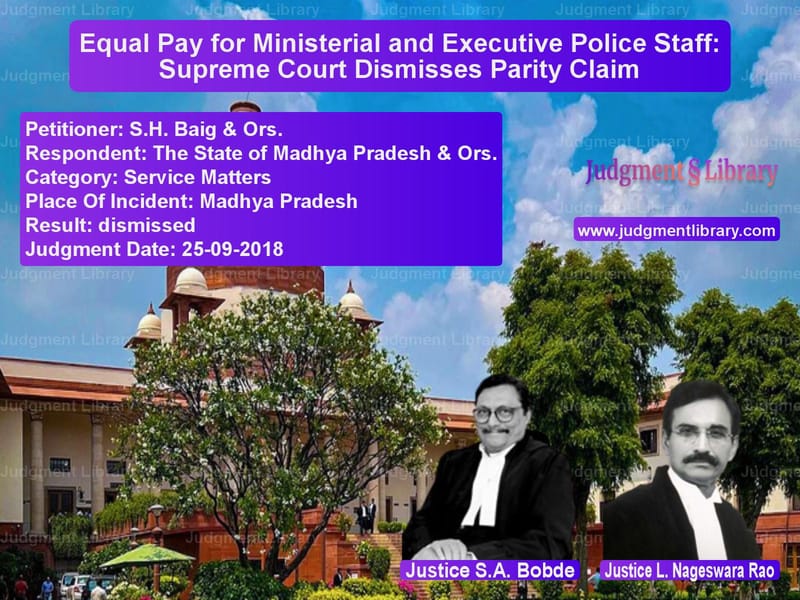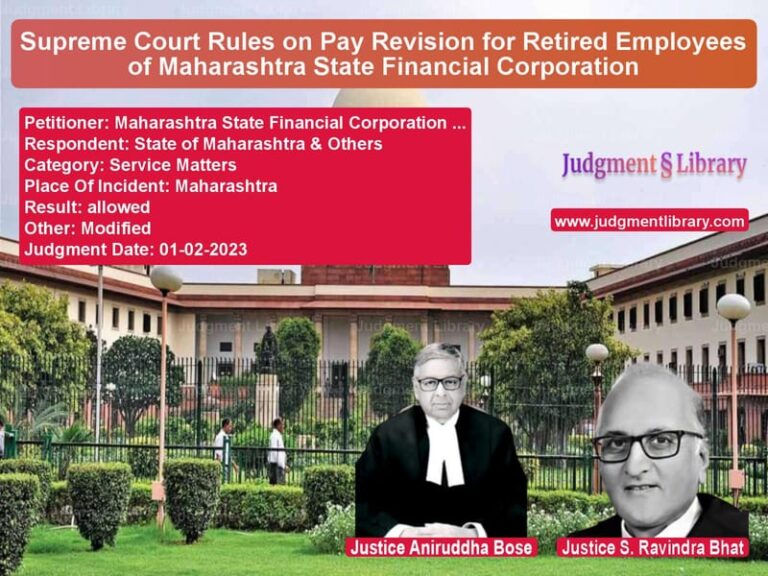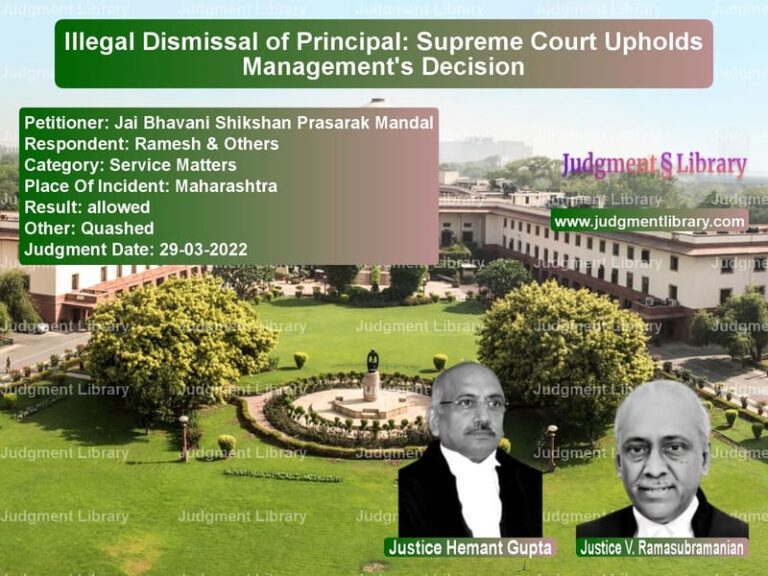Equal Pay for Ministerial and Executive Police Staff: Supreme Court Dismisses Parity Claim
The Supreme Court of India, in its judgment dated September 25, 2018, in the case of S.H. Baig & Ors. vs. The State of Madhya Pradesh & Ors., dealt with the long-standing issue of pay parity between ministerial employees and executive police officers in the state of Madhya Pradesh. The judgment addressed whether ministerial employees, who were given police ranks, should receive the same pay scales as executive officers.
Background of the Case
The appellants, who were ministerial staff in the Madhya Pradesh Police Department, had initially been governed by the M.P. Police Regulations framed under the Police Act, 1861. Their counterparts in the executive force, including inspectors, sub-inspectors, and assistant sub-inspectors, were governed by different regulations.
On November 5, 1967, the Madhya Pradesh government created a new category of Police Ranks (Ministerial). Ministerial employees who opted for these ranks were allowed to continue receiving their existing salaries but were entitled to uniform grants and allowances similar to those of the executive police force.
However, a pay disparity existed between the two categories of employees:
- The executive force received higher pay scales.
- The ministerial staff continued to receive the pay scales applicable to their counterparts in other departments.
Ministerial employees in the police force argued that since they had been granted police ranks and performed duties in police stations, they should receive the same pay scales as executive officers.
Lower Court and Tribunal Decisions
The dispute regarding pay parity arose when some ministerial employees, including P.N. Tripathi and Krishna Gopal Duraphe, challenged their pay scales before the Administrative Tribunal. The tribunal ruled in favor of these employees, directing the state government to grant them additional increments.
Following the tribunal’s decisions, the Madhya Pradesh government took steps to extend a special ad hoc increase of Rs.70 per month to ministerial staff. However, this increase did not equate to full pay parity with executive police officers.
Subsequent challenges led to multiple rulings by the tribunal, reinforcing the claim for parity. However, the state government maintained that the duties of ministerial employees were different from those of executive officers and that they could not be placed in the same pay scale.
High Court’s Ruling
The Madhya Pradesh High Court ruled against the ministerial employees, stating:
- The 1967 memorandum did not entitle ministerial staff to pay parity with executive officers.
- Ministerial employees performed clerical and administrative tasks, whereas executive officers performed policing duties, which included law enforcement and maintaining public order.
- The revision of pay scales, as per the M.P. Revision of Pay Rules, 1983, explicitly excluded ministerial employees from the higher pay scales granted to executive officers.
The High Court concluded that ministerial employees could not claim the same salary as the executive force since their job responsibilities, qualifications, and recruitment processes were different.
Supreme Court’s Observations
The ministerial employees challenged the High Court’s ruling before the Supreme Court, arguing that:
- After being granted police ranks, they were functionally part of the police force.
- They performed critical administrative duties that supported law enforcement operations.
- Some ministerial staff had even been appointed as Deputy Superintendents of Police (DSPs) and were involved in policing activities.
The state government countered these claims by asserting that:
- The recruitment process for ministerial and executive officers was distinct, with different qualifications and training.
- Ministerial staff continued to draw their existing pay even after being given police ranks.
- The administrative and clerical work performed by ministerial employees did not equate to the operational duties of executive police officers.
Supreme Court’s Ruling
The Supreme Court upheld the High Court’s decision, ruling that:
- Granting police ranks to ministerial employees did not automatically entitle them to executive police pay scales.
- There was a clear distinction between executive policing (which involved maintaining law and order) and ministerial work (which involved administrative tasks).
- The principle of equal pay for equal work could not be applied in this case because the job responsibilities of the two categories of employees were different.
- The pay disparity was justified under the M.P. Revision of Pay Rules, 1983, and the recommendations of the Chaudhary Pay Commission.
The Court also ruled that while the ministerial employees could not claim pay parity, the state government’s attempt to recover excess payments made between January 1, 2000, and November 17, 2001, was not justified. The Court ruled that no recoveries should be made for that period.
Implications of the Judgment
This ruling has several key implications for public sector employment policies:
- Clarification on Pay Parity: The judgment reinforces that employees in different roles cannot demand identical pay scales solely based on being part of the same department.
- Distinct Pay Structures in Law Enforcement: Ministerial staff in the police force cannot claim the same benefits as executive officers unless their job functions are comparable.
- Recognition of Administrative Roles: While the ruling denied pay parity, it acknowledged that ministerial employees play a crucial supporting role in policing.
- Precedent for Other Public Sector Employees: The decision may influence similar cases in other government departments where clerical staff seek pay parity with field officers.
Final Verdict
The Supreme Court dismissed the appeals and upheld the High Court’s judgment:
- Ministerial employees in the Madhya Pradesh Police Department cannot claim pay parity with executive officers.
- The existing pay scales assigned to ministerial staff remain valid.
- No recoveries will be made for excess payments between January 1, 2000, and November 17, 2001.
This landmark ruling upholds the distinction between administrative and law enforcement roles, ensuring that pay scales reflect the nature of duties performed by different categories of employees.
Petitioner Name: S.H. Baig & Ors..Respondent Name: The State of Madhya Pradesh & Ors..Judgment By: Justice S.A. Bobde, Justice L. Nageswara Rao.Place Of Incident: Madhya Pradesh.Judgment Date: 25-09-2018.
Don’t miss out on the full details! Download the complete judgment in PDF format below and gain valuable insights instantly!
Download Judgment: S.H. Baig & Ors. vs The State of Madhya Supreme Court of India Judgment Dated 25-09-2018.pdf
Direct Downlaod Judgment: Direct downlaod this Judgment
See all petitions in Employment Disputes
See all petitions in Public Sector Employees
See all petitions in Promotion Cases
See all petitions in Judgment by S. A. Bobde
See all petitions in Judgment by L. Nageswara Rao
See all petitions in dismissed
See all petitions in supreme court of India judgments September 2018
See all petitions in 2018 judgments
See all posts in Service Matters Category
See all allowed petitions in Service Matters Category
See all Dismissed petitions in Service Matters Category
See all partially allowed petitions in Service Matters Category







